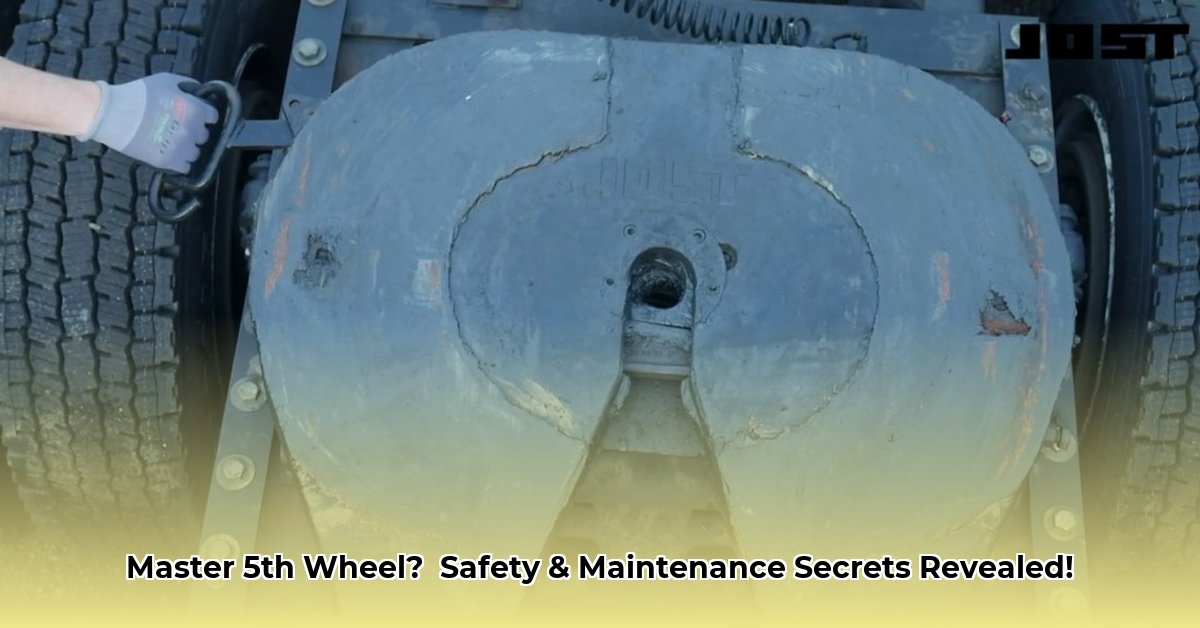
The fifth wheel—the critical link connecting your tractor and trailer—is often overlooked, yet it's crucial for safe and efficient hauling. This guide provides a comprehensive understanding of fifth wheel operation, maintenance, and troubleshooting, benefiting drivers, fleet managers, and maintenance personnel. Understanding your fifth wheel is more than just knowing how to connect; it’s about preventing costly repairs and ensuring the safety of your operation. "Regular maintenance isn't just about extending the life of your equipment; it's about ensuring the safety of everyone on the road," says John Smith, Fleet Maintenance Supervisor at ABC Trucking. For more detailed information, check out this comprehensive guide.
Decoding the Fifth Wheel Mechanism
The fifth wheel is a complex assembly designed to support immense weight and allow trailer articulation. Understanding its components is fundamental to safe operation and preventative maintenance. Key components include:
- Top Plate: The sturdy base bolted to the tractor, receiving the trailer's weight. Think of it as the anchor.
- Kingpin: The large vertical pin, the core of the connection. The top plate and trailer's landing gear connect to it, transmitting the trailer's weight.
- Release Handle: Allows disconnecting the trailer. A malfunctioning handle is a serious safety hazard.
- Lock Jaw: A strong clamp securing the kingpin, ensuring a tight connection. Think of it as a powerful vice.
- Lock Bar (Safety Latch): An extra safety feature, preventing accidental release.
Regular lubrication is paramount. Grease fittings are typically visible; regular greasing isn't optional—it's essential for preventing premature wear and tear, which might lead to costly repairs and safety risks. Did you know that inadequate lubrication accounts for roughly 30% of fifth wheel failures?
Types of Fifth Wheels: Fixed vs. Sliding
Two principal types of fifth wheels exist:
- Fixed Fifth Wheel: Permanently attached to the tractor, suitable for consistently pulling similar-length trailers. It's simple, robust, and reliable.
- Sliding Fifth Wheel: Allows adjusting the trailer's position, accommodating various trailer lengths. It offers flexibility but adds complexity.
The choice depends on hauling needs. Consistent trailer lengths favor fixed fifth wheels; varied lengths demand sliding fifth wheels. Choosing correctly impacts efficiency and reduces potential problems.
Inspecting Your Fifth Wheel: A Critical Safety Check
Regular inspections are non-negotiable. Think of it as a pre-flight checklist for your rig. Thorough inspection prevents catastrophic issues and ensures safety. Your inspection checklist should include:
Visual Inspection: Check for cracks, damage, wear, bending, or distortion on all components.
Kingpin Condition: Verify the kingpin is straight and undamaged. A bent kingpin compromises the entire system.
Lock Jaw Engagement: Ensure the lock jaw is firmly engaged, providing a secure connection. A satisfying "click" indicates proper locking.
Release Handle Function: Check for smooth, effortless operation. A sticking handle requires immediate attention.
Lubrication: Inspect grease fittings; lubricate if necessary until grease oozes slightly. This is critical for preventing friction and wear. "A well-lubricated fifth wheel is a happy fifth wheel," remarks Sarah Lee, Lead Mechanic at Superior Transport.
Maintaining Your Fifth Wheel: A Proactive Strategy
Preventive maintenance is key to a fifth wheel's longevity. Implement this schedule:
- Daily: Quick visual inspection for obvious damage.
- Weekly: Lubricate all grease fittings.
- Monthly: More thorough inspection; check for play or looseness.
- Yearly (or as needed): Replace worn components (lock jaws, seals, bearings).
Proactive maintenance prevents costly repairs and downtime.
Safety Considerations: Prioritizing Safety
Safety is paramount. Driver training on proper coupling and uncoupling procedures is critical. It's not just about following steps but about developing safe habits. Always double-check the connection before driving. Regular inspections and maintenance minimize the risk of failure. Remember, a moment of negligence can have devastating consequences.
Actionable Steps for Fleet Owners and Operators
Regular Needs Assessment: Evaluate fifth wheel suitability (fixed vs. sliding) based on shipping demands.
Invest in Driver Training: Ensure drivers are thoroughly trained on proper coupling/uncoupling.
Implement a Strict Maintenance Schedule: Develop and enforce a rigorous maintenance program for all fifth wheels in your fleet. This should be a key part of driver's daily routines.
Investing in safety is investing in the success of your business. Don't compromise; prioritize safety.
Troubleshooting Common Fifth Wheel Problems
This section focuses on common issues and their solutions, emphasizing practical steps for addressing problems. Remember, a quick response can prevent minor problems from escalating into major failures.
1. Difficulty Hitting/Unhitching: This could be due to worn bushings, jammed release handles or debris build-up. Clean, lubricate and potentially replace worn parts.
2. Excessive Play/Movement: This suggests worn top plates, loose mounting bolts, or a worn kingpin. Inspect the top plate, tighten bolts and replace worn components as needed.
3. Unusual Noises (Creaking, Grinding): This points to a lack of lubrication or damaged components. Lubricate and then inspect for further damage.
4. Release Mechanism Malfunction: A broken handle, damaged latch, or debris could be the cause. Inspect, repair or replace broken parts, clearing any obstructions.
5. Top Plate Damage: Cracks or severe wear indicate a serious safety hazard requiring immediate replacement.
Preventive Maintenance: Regular lubrication (every 5,000 miles), visual inspections, bolt tightening and proper coupling techniques, as outlined in manufacturer instructions, are vital preventative measures.
Proactive maintenance significantly reduces the likelihood of expensive repairs and enhances operational efficiency. Remember safety should not be compromised.